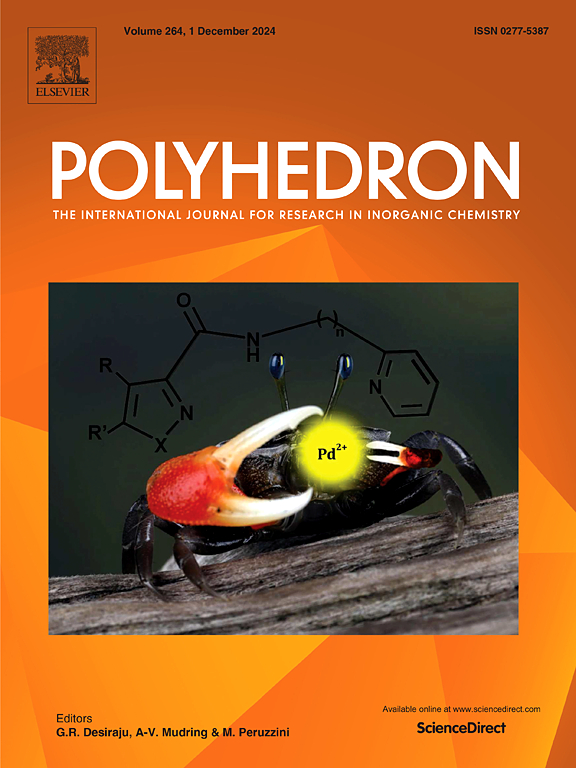乙烯环氧化酶激发催化剂
IF 2.6
3区 化学
Q2 CHEMISTRY, INORGANIC & NUCLEAR
引用次数: 0
摘要
环氧乙烷(EO)是合成几种化学品和燃料的主要工业前体。近年来,降低环氧化成本和提高产物选择性的催化剂设计技术已成为人们关注的焦点。本研究采用密度泛函理论方法和电子结构分析研究了六种酶激发催化剂在常温和温和氧化剂(N2O)条件下环氧化乙烯的效率。我们考虑了一个金属嵌入卟啉框架,模拟细胞色素P450酶的微环境来构建模型催化剂。三个过渡金属原子,Mn, Fe和Co,被选为活性位点。轴向半胱氨酸链被巯基配体修饰以减少计算成本。Mn和Fe配合物表现出中间至较高的自旋态是最稳定的,而Co配合物表现出低至中间的自旋态是首选的基态。通过对反应热力学和动力学势垒的比较,确定了可行的反应机理和参与反应的活性中间体。活化势垒随金属中心边界d态的占有而变化。在四重奏(IS)和五重奏自旋(HS)态不含轴向硫醇配体的Mn和fe包埋卟啉框架显示出最有效的环氧化物生成活性和选择性。中间体的自旋密度分析表明,反应倾向于自由基途径。本文章由计算机程序翻译,如有差异,请以英文原文为准。

Enzyme-inspired catalysts for ethylene epoxidation
Ethylene oxide (EO) is a primary industrial precursor for synthesizing several chemicals and fuels. In recent years, efficient design techniques for catalysts to reduce the cost of epoxidation and improve product selectivity have been of prime interest. This study uses the Density Functional Theory method and electronic structure analysis to investigate the efficiency of six enzyme-inspired catalysts for epoxidation of ethylene under ambient temperature and mild oxidizing agent (N2O). We consider a metal-embedded porphyrin framework mimicking the micro-environment of the cytochrome P450 enzyme to build the model catalysts. The three transition metal atoms, Mn, Fe, and Co, are chosen as the active sites. The axial cysteine linkage is modified with a thiol ligand to reduce the computational cost. Mn and Fe complexes show intermediate to higher spin states as the most stable, whereas Co complexes show low to intermediate spin states as the preferred ground state. Comparing the reaction thermodynamics and kinetic energy barriers, we determine the feasible reaction mechanism and the active intermediates involved during the reaction. The activation barriers vary based on the occupancy of the frontier d-states of the metal centers. The Mn and Fe-embedded porphyrin framework without the axial thiol ligand at the quartet (IS) and quintet spin (HS) states shows the most efficient activity and selectivity for epoxide formation. The spin density analysis of the intermediates shows that the reaction prefers a radical pathway.
求助全文
通过发布文献求助,成功后即可免费获取论文全文。
去求助
来源期刊

Polyhedron
化学-晶体学
CiteScore
4.90
自引率
7.70%
发文量
515
审稿时长
2 months
期刊介绍:
Polyhedron publishes original, fundamental, experimental and theoretical work of the highest quality in all the major areas of inorganic chemistry. This includes synthetic chemistry, coordination chemistry, organometallic chemistry, bioinorganic chemistry, and solid-state and materials chemistry.
Papers should be significant pieces of work, and all new compounds must be appropriately characterized. The inclusion of single-crystal X-ray structural data is strongly encouraged, but papers reporting only the X-ray structure determination of a single compound will usually not be considered. Papers on solid-state or materials chemistry will be expected to have a significant molecular chemistry component (such as the synthesis and characterization of the molecular precursors and/or a systematic study of the use of different precursors or reaction conditions) or demonstrate a cutting-edge application (for example inorganic materials for energy applications). Papers dealing only with stability constants are not considered.
 求助内容:
求助内容: 应助结果提醒方式:
应助结果提醒方式:


